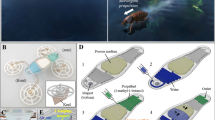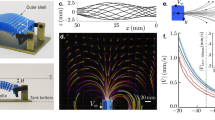Abstract
In this work, we initiated the effort of developing a so-called water microflotilla, which was capable of moving on a water surface. We explored its design, fabrication, propulsion, and motions in straight and circular channels. A water microflotilla comprised five microboats connected with a Nylon rope, and was fabricated using ultra-violet lithographic techniques. It was actuated by the difference between fore-and-aft surface tensions. The water microflotilla was tested in three straight and one circular channels at water levels of 3, 6 and 9 mm, respectively. In all the tests, the microflotilla moved like a rigid object, and no collisions were observed between neighboring microboats. Travel distances were above 0.44 m, and average speeds varied from 40.2 to 103.2 mm/s. Both the travel distances and the average speeds were found to increase with the increasing water depth and channel width. The two ends of the microflotilla had direct contact with the outer sidewall of the circular channel during a circular motion. The support forces of the outer sidewall at these contact points provided the centripetal force needed for the circular motion. Compared with a single microboat, such a microflotilla can be potentially employed to transport a large amount of supply in small-scale fluidic applications.









Similar content being viewed by others
References
Anthony JB (2002) Trains and technology, the American railroad in the nineteenth century, vol 1–4, Associated University Presses, Cranbury
Bush J, David Hu D (2006) Walking on water: biolocomotion at the interface. Annu Rev Fluid Mech 38:339–369
Chung SK, Ryu K, Cho SK (2009) A surface-tension-driven propulsion and rotation principle for water-floating mini/micro robots. The 22nd International Conference on Micro Electro Mechanical Systems, pp 1083–1086
Comstock JC (ed) (1967) Principles of naval architecture. The Society of Naval Architects and Marine Engineers, New York, pp 301–311
Fan LS, Tai YC, Muller RS (1989) IC-processed electrostatic micromotors. Sens Actuat 20:41
Fearing RS, Chiang KH, Dickinson M, Pick DL, Sitti M, Yan J (2000) Wing transmission for a micromechanical flying insect. IEEE international conference on robotics and automation (San Francisco), pp 1509–1516
Gere JM (2004) Mechanics of materials, 6th edn. Brooks/Cole-Thomson Learning, Belmont
Luo C, Meng F, Francis A (2006) A new molding process to fabricate silicon reinforced PDMS masters. Microelectron J 37:1036
Luo C, Li H, Liu X (2008) Propulsion of microboats using isopropyl alcohol as a propellant. J Micromech Microeng 18:067002
Luo C, Qiao L, Li H (2010) Dramatic squat and trim phenomena of mm-scaled SU-8 boats induced by Marangoni effect. Microfluid Nanofluid 9:573–577
Marcus A (2009) Micro-boat walks the walk–on water-miniature vessel mimics insect larvae by using surface tension for propulsion. Scientific America
Meissner HP, Michaels AS (1949) Surface tensions of pure liquids and liquid mixtures. Ind Eng Chem 41:2782
MicroChem Corporation (2007) Data sheet of SU-8 manufacturer. http://www.microchem.com/products/pdf/SU-8-table-of-properties.pdf
Pennycuick CJ (1971) Gliding flight of the white-backed vulture Gyps africanus. J Exp Biol 55:13
Scriven LE, Sternling CV (1960) The marangoni effects. Nature 187:186
Sheng ZB, Liu YZ (eds) (2003) Principles of ships. Part I. Publishers of Shanghai Jiao Tong University, Shanghai, China, pp 293–301 (in Chinese)
Tang WC, Nguyen TCH, Howe RT (1989) Laterally driven polysilicon resonant microstructures. Sens Actuat 20:25
Timoshenko SP, Gere JM (1963) Theory of elastic stability, 2nd edn. McGraw-Hill, New York (Chapter 1)
Tupper EC (2004) Introduction to naval architecture, 4th edn. Butterworth Heinemann, Oxford (Section 9)
Author information
Authors and Affiliations
Corresponding author
Rights and permissions
About this article
Cite this article
Li, H., Luo, C. Development of a self-propelled microflotilla. Microsyst Technol 17, 777–786 (2011). https://doi.org/10.1007/s00542-010-1178-6
Received:
Accepted:
Published:
Issue Date:
DOI: https://doi.org/10.1007/s00542-010-1178-6




